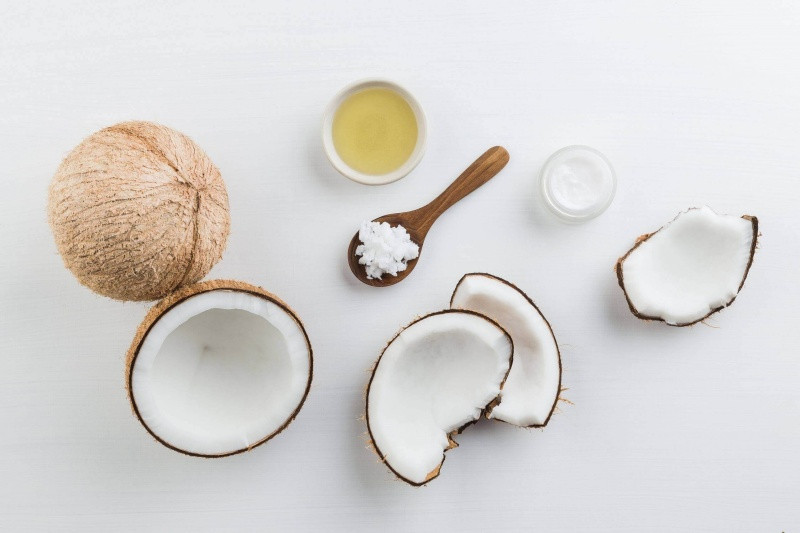Reviewed By: Kacie La
Contents:
Coconut is known in the tropics as the miracle tree, and for good reasons. Every part of this tree, from the leaves to the roots, can be harvested and utilised for a wide range of applications. Its roots are boiled to make medicine and tonic, the leaves are weaved to make roofs and food wraps, the shell burnt to produce activated charcoal, and much more.
One product from coconut that has been taking the pharmaceutical and cosmetic industry by storm for years now is its oil. Considered one of the best carrier oils for essential oils, coconut oil exhibits amazing properties and can be utilised for a wide range of purposes.
There are two main different types of coconut oil: coconut oil RBD and fractionated coconut oil. In this article, we will be focussing on the different benefits and uses of fractionated coconut oil and how you can add it to your lifestyle routine in various ways.
What is fractionated coconut oil?
Extra virgin coconut oil contains eight different type of fatty acids, about 50 per cent of which is lauric acid or C12. These fatty acids give coconut oil its thick and oily characteristic, which isn’t as beneficial for some applications such as when the coconut oil must be kept in fluid form for longer. That’s when fractionating coconut oil became a practice.
The fatty acids in coconut oil come from its medium-chain triglyceride (MCT) content. These fatty acids are characterised by their atomic composition or molecular structure, which also defines the rate by which they solidify at room temperature.
To keep the coconut oil in liquid form, some of the fatty acids, particularly those that solidify quickly are separated or removed through a process called fractionation. Simply put, fractionated coconut oil is just regular coconut oil but without some or most of its fatty acids. What’s usually left are caprylic/octanoic acid and capric/decanoic acid.
How to Make Fractionated Coconut Oil
As mentioned earlier, fractionation is the process of separating fatty acids that have high melting points. This is carried out simply by melting coconut oil and letting it cool down slowly at room temperature. After a few minutes, long-chain fatty acids or those with high melting points such as lauric acid, which represent a “fraction” of the entire volume of the coconut oil, are expected to solidify. This fraction is then removed, hence fractionation.
If you want to make fractionated coconut oil at home, the process isn’t as challenging as you may think! Once you melt your coconut oil and let it cool to room temperature, some of the components in the coconut oil will solidify. Remove the remaining liquid, and you have your fractionated coconut oil!
Cosmetic Benefits of Fractionated Coconut Oil
If you’re not a big fan of coconut oil due to its high viscosity, consider using fractionated coconut oil instead. Its unique properties make it extremely useful for applications where regular coconut oil isn’t suitable. Some of its uses include:
A Smooth Massage Oil
Fractionated coconut oil works so much better than regular virgin or extra virgin coconut oil when mixed with essential oils used for body massage. Not only is it less greasy when applied on the skin, but it also allows for smoother and easier movement as the hands glide over the skin. You can mix it with your favourite essential oil to create your own unique massage oil! Our personal favourites are lavender essential oil and eucalyptus essential oil.
Better Viscosity Than Coconut Oil RBD
Viscosity affects a carrier oil’s ability to dilute essential oils. The higher the viscosity, the longer dilution takes. Because fractionated coconut oil has fewer fatty acids than regular coconut oil, it dilutes essential oils faster. Its lighter texture and better fluidity ensure that essential oils mix evenly, which is why fractionated coconut oil is preferred over regular coconut oil (RBD) when working with essential oils.
Haircare
Fractionated coconut oil, often praised for its lightweight and non-greasy texture, is a popular choice in hair care routines. Its natural composition includes essential fatty acids and vitamins that can help to improve the appearance of the hair.
When applied topically, it may assist in reducing the impression of frizz and add shine. Due to its neutral scent and ease of application, fractionated coconut oil is commonly used as a carrier for essential oils or in DIY hair masks and leave-in treatments. We recommend mixing three to five drops of rosemary essential oil with your fractionated hair oil and applying it to the roots and lengths of your hair. Leave it in for four to six hours before washing out with your normal hair wash routine.
DIY Fractionated Coconut Oil Crafts
Fractionated coconut oil is also great for homemade crafts and household goods, such as DIY candles and soaps. Its neutral scent won't overpower the fragrance of essential oils or other additives, making it a popular base in candle-making.
Additionally, when used in soap recipes, fractionated coconut oil contributes to a luxurious lather, creating an enjoyable showering or bathing experience. Its smooth texture and easy incorporation into various craft projects make it a go-to option for those looking to add a touch of personalisation and natural goodness to their creations.
Fractionated coconut oil offers a plethora of benefits for personal and cosmetic use. It is not difficult to make at home, but otherwise, it can be bought online from N-Essentials! We offer a wide range of essential oils, carrier oils, and raw ingredients for you to use however you please. Shop the range online, or feel free to contact us if you require any assistance!












